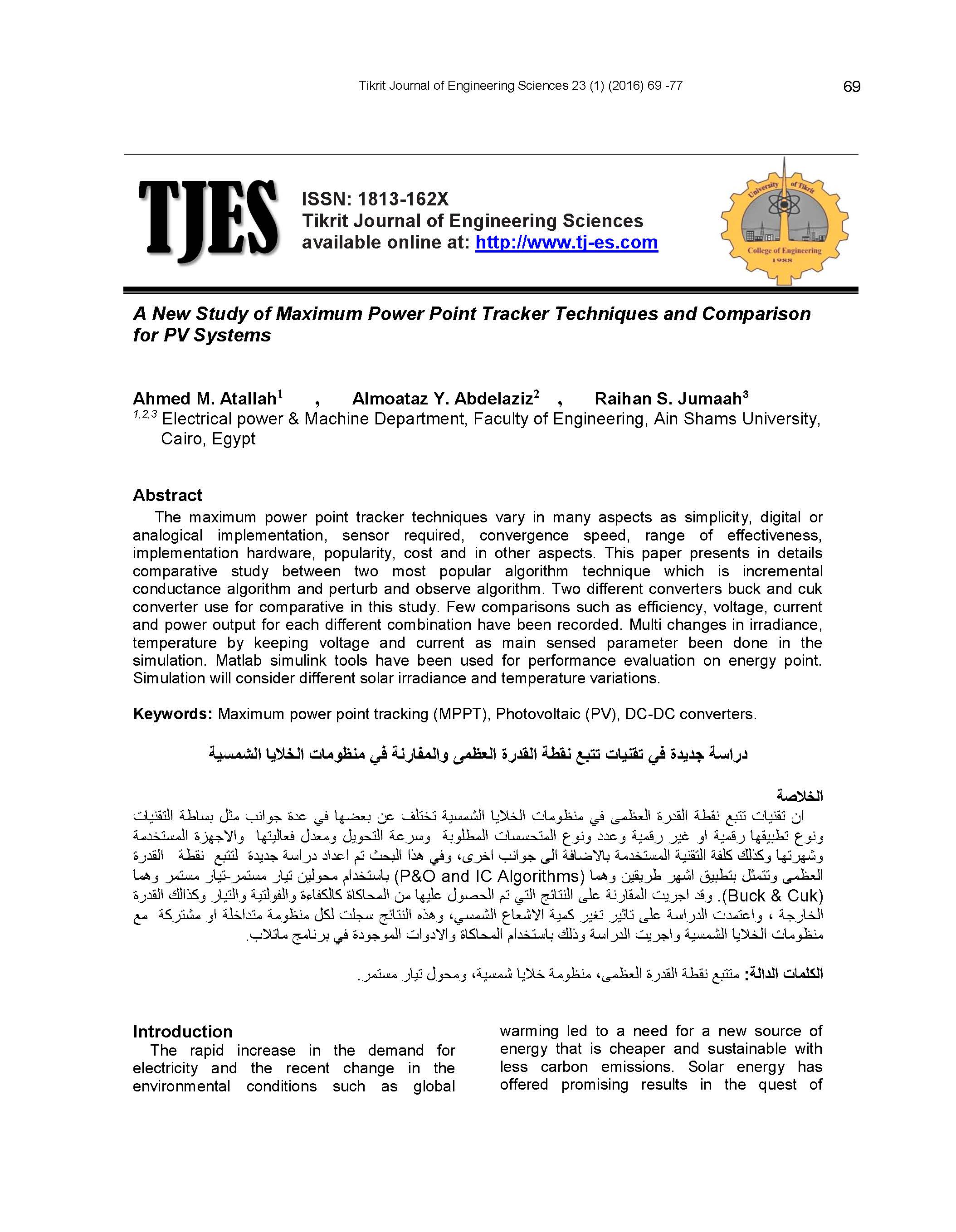A New Study of Maximum Power Point Tracker Techniques and Comparison for PV Systems
Main Article Content
Abstract
The maximum power point tracker techniques vary in many aspects as simplicity, digital or analogical implementation, sensor required, convergence speed, range of effectiveness, implementation hardware, popularity, cost and in other aspects. This paper presents in details comparative study between two most popular algorithm technique which is incremental conductance algorithm and perturb and observe algorithm. Two different converters buck and cuk converter use for comparative in this study. Few comparisons such as efficiency, voltage, current and power output for each different combination have been recorded. Multi changes in irradiance, temperature by keeping voltage and current as main sensed parameter been done in the simulation. Matlab simulink tools have been used for performance evaluation on energy point. Simulation will consider different solar irradiance and temperature variations.
Metrics
Article Details

This work is licensed under a Creative Commons Attribution 4.0 International License.
THIS IS AN OPEN ACCESS ARTICLE UNDER THE CC BY LICENSE http://creativecommons.org/licenses/by/4.0/
Plaudit
References
- R. S. Lewis, “Antartic Research and Relevant of Science”, in Bulletin of the Atomic Scientists, Vol. 26, 1970, pp. 2. DOI: https://doi.org/10.1080/00963402.1970.11457864
- Y. H. Chang and C.Y. Chang, "A Maximum Power Point Tracking of PV System by Scaling Fuzzy Control", presented at International Multi Conference of Engineers and Computer Scientists, Hong Kong, 2010.
- S. Mekhilef, “Performance of Grid Connected Inverter with Maximum Power Point Tracker and Power Factor Control”, International Journal of Power Electronics, Vol. 1, pp. 49-62, 2008. DOI: https://doi.org/10.1504/IJPELEC.2008.021006
- M.E. Ahmad and S. Mekhilef , "Design and Implementation of a Multi-Level Three-Phase Inverter with Less Switches and Low Output Voltage Distortion," Journal of Power Electronics, Vol. 9, pp. 594-604, 2009.
- S. Chin, J. Gadson and K. Nordstrom, "Maximum Power Point Tracker", Tufts University Department of Electrical Engineering and Computer Science, 2003, pp. 1-66.
- R. Faranda and S. Leva, "Energy Comparison of MPPT Techniques for PV Systems", WSES Transaction on Power Systems, Vol. 3, pp. 446-455, 2008
- Vikrant A. Chaudhari, "Automatic Peak Power Traker for Solar PV Modules Using dSpacer Software", in Maulana Azad National Institute Of Technology, Degree of Master of Technology In Energy. Bhopal: Deemed University, 2005, pp. 98.
- T. P. Nguyen, "Solar Panel Maximum Power Point Tracker," in Department of Computer Science & Electrical Engineering: University of Queensland, 2001, pp. 64.
- B. S, Thansoe, N. A, R. G, K. A.S., and L. C. J. "The Study and Evaluation of Maximum Power Point Tracking Systems", International Conference on Energy and Environment 2006 (ICEE 2006), pp. 17-22, 2006.
- C. S. Lee, " A Residential DC Distribution Syste with Photovoltaic Array Integration", Degree of Honors Baccalaureate of Science in Electrical and Electronics Engineering, 2008, pp. 38.
- T. Esram and P. L. Chapman, "Comparison of Photovoltaic Array Maximum Power Point Tracking Techniques", in 9. Urbana.
- E. I and O. Rivera, "Maximum Power Point Tracking using the Optimal Duty Ratio for DC-DC Converters and Load Matching in Photovoltaic Applications", IEEE, pp. 987-991, 2008.
- G. Adamidis, P. Bakas, and A . Ba louktsis," Photovoltaic System MPP Tracker Implementation using DSP Engine and Buck – Boost DC-DC Converter"
- M. Azab, "A New Maximum Power Point Tracking for Photovoltaic Systems", in WASET.ORG, Vol. 34, 2008, pp. 571- 574.
- H. Knopf, "Analysis, Simulation, And Evaluation of Maximum Power Point Tracking (MPPT) Methods for a Solar Power Vehicle", in Electrical and Computer Engineering, Master of Science in Electrical and Computer Engineering: Portland State University 1999, pp. 177.
- T.S.USTUN and S . Mekhilef, "Effects of a Static Synchronous Series Compensator (SSSC) Based on Soft Switching 48 Pulse PWM Inverter on the Power Demand from the Grid", Journal of Power Electronics, Vol. 10, pp. 85-90, 2010 DOI: https://doi.org/10.6113/JPE.2010.10.1.085
- A. Oi, "Design and Simulation of Photovoltaic Water Pumping System," in Electrical Engineering. Master of Science in Electrical Engineering. San Luis Obispo: California Polytechnic State University, 2005, pp. 113.
- S. Mekhilef and M. N. A. Kadir, "Voltage Control of Three-Stage Hybrid Multilevel Inverter Using Vector Transformation" IEEE
Transactions on Power Electronics, Vol. 25, pp. 2599-2606, 2010. DOI: https://doi.org/10.1109/TPEL.2010.2051040
- S. Azadeh and S. Mekhilef, "Simulation and Hardware Implementation of Incremental Conductance MPPT with Direct Control Method Using Cuk Converter," IEEE Transaction on Industrial Electronics. DOI:10.1109/TIE.2010.2048834, 2010. DOI: https://doi.org/10.1109/TIE.2010.2048834
- P. Sanchis, J. Lopez, A. Ursua, E. Gubia , and L. Marroyo, "On the Testing, Characterization , and Evaluation of PV Inverters and Dynamic MPPT Performance Under Real Varying Operating Conditions", 2007. DOI: https://doi.org/10.1002/pip.763
- B. S. Energy, "What is Maximum Power Point Tracking (MPPT)", 2009.
- J. H. Lee, H. S. Bae, and B. H. Cho, "Advanced Incremental Conductance MPPT Algorithm with a Variable Step Size", 2006.





